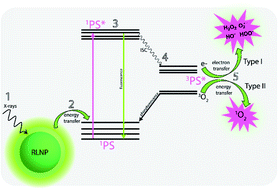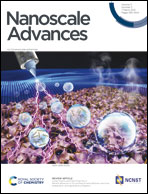Investigating the reactive oxygen species production of Rose Bengal and Merocyanine 540-loaded radioluminescent nanoparticles†
Abstract
Radioluminescent nanomaterials have garnered significant attention in the past decade due to their potential to perform X-ray mediated photodynamic therapy (X-PDT). Many of these materials are assumed to produce singlet oxygen based on a single assay. Herein we demonstrate that multiple assays are required to confidently determine whether singlet oxygen or other reactive oxygen species are being produced through type I or type II PDT mechanisms. Rose Bengal and Merocyanine 540 photosensitizers were loaded into mesoporous silica-coated NaLuF4:Dy3+,Gd3+ nanoparticles and the combination of ABDA, DPBF, and NaN3 assays along with electron paramagnetic resonance were employed to determine that superoxide and hydroxyl radicals were exclusively produced from this system under X-ray excitation. Knowledge of the correct PDT mechanism is crucial for informing what types of disease may be best suited for treatment using PDT nanosystems.



 Please wait while we load your content...
Please wait while we load your content...